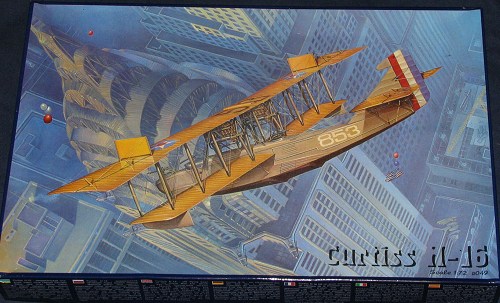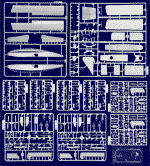
| KIT: | Roden 1/72 Curtiss H-16 Flying Boat |
| KIT #: | 0049 |
| PRICE: | $24.98 (19.96 at Squadron) |
| DECALS: | options |
| REVIEWER: | Scott Van Aken |
| NOTES: |

| HISTORY |
Thanks toRoden for the historical background information
| THE KIT |
 If you have seen the preview on the Felixstowe F.2A flying boats, then you pretty well know what to expect from this kit. There are few differences since the H-16 was a US built F.2A. In fact, just about the only visual difference is the rudder. Since Roden and others like to use multiple sprues, especially when there are a lot of duplicate parts as on multi-engine aircraft, you'll find two extra rudders! That makes this kit basically a decal change from the previous F.2A kit.
If you have seen the preview on the Felixstowe F.2A flying boats, then you pretty well know what to expect from this kit. There are few differences since the H-16 was a US built F.2A. In fact, just about the only visual difference is the rudder. Since Roden and others like to use multiple sprues, especially when there are a lot of duplicate parts as on multi-engine aircraft, you'll find two extra rudders! That makes this kit basically a decal change from the previous F.2A kit.
Just like the previous kit, there are a lot of very small parts and so this kit would be best tackled by someone who has had some experience in doing WWI aircraft. This is especially so as the rigging is quite extensive. Fortunately, Roden has taken that into account and has provided an excellent rigging diagram. The overall quality of the molded parts is excellent. Roden has done a lot of work to ensure that you won't be disappointed by the detail. It is up to the builder to make the best of what is provided.
Their instructions are quite comprehensive and very informative when it comes to some of the detail areas. You have color information provided with both generic names and current Humbrol paint references. Decals are well printed, though my copy had a bit of smearing of colors in a few instances, leaving rather ragged demarcation lines in a few areas. I have heard that Roden has improved the 'stick' of their decals so these should work well with various setting solutions. Only actually using them will tell. Markings are for four aircraft. The main colors on these aircraft are various shades of grey and in some cases, the wings are in natural linen. The lone British example is in browns. On the sheet are:

Curtiss H16, s/n N4892, based at Felixstowe, May 1918, Curtiss H16, K-29, based at Killingholme 1918,1, Curtiss H16, A-845, U.S. Navy, 1920s, Curtiss H16, A-1032, Based at Lough Foyle, 1918.
| CONCLUSIONS |
Overall, this is an excellent looking kit. Because of all the detail, small parts and rigging, it would not be my first choice for a beginner, but those who are somewhat experienced with WWI aircraft will find this one to be a beauty when finished.
You can find this kit and many others at
If you would like your product reviewed fairly and fairly quickly by asite that has nearly 300,000 visitors a month, please contactme or see other details in the